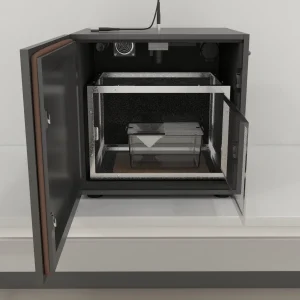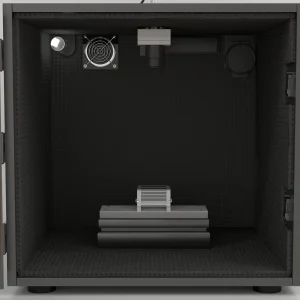$6,590.00 – $10,490.00Price range: $6,590.00 through $10,490.00
The AutoSom™ system is an advanced automated tool designed for sleep-deprivation studies in rodents. This system facilitates non-invasive, fully automated monitoring of rodents’ sleep and wakefulness with precise regulation.
The setup includes a floor-sensor board that picks up vibrations caused by the mouse’s movements within its home cage. Beneath this board, a motor drives a rotating bar to keep the animal awake.
The system manages up to four units, all connected to a single computer via USB. It uses vibration signals to determine whether the rodent is active or inactive (asleep), and an infrared array tracks the animal’s location and movement.

MazeEngineers empowers preclinical neuroscience research with meticulously designed, customizable behavioral apparatuses. From manual classic mazes to fully automated smart systems, we provide the tools scientists need to capture high-quality, reproducible data for studies on learning, memory, anxiety, and depression.



Mouse |
(12.5” L x 8.5” W x 3.5” H) |
CageCenter software included |
Multiple assays at the same time with multiple-biosensors |
Modular devices with flexibility in the assay |
USB operation |
All assays can be conducted at normal homecage |
Highly automated |
Active/inactive data |
Locomotion and rearing data |
Rat |
(18.4” L x 10.7” W x 4.5” H) |
CageCenter software included |
Multiple assays at the same time with multiple-biosensors |
Modular devices with flexibility in the assay |
USB operation |
All assays can be conducted at normal homecage |
Highly automated |
Active/inactive data |
Locomotion and rearing data |

The AutoSom™ system is an advanced automated tool specifically designed for conducting sleep research in rodents. This system provides precise, non-invasive monitoring of rodents’ sleep and wakefulness, offering a controlled and regulated environment for research. It utilizes a gentle, non-stressful stimulus to keep mice awake, with easy manual adjustment options for the stimulus. The system incorporates automated sensors and a floor pad to track and record sleep/wake patterns, making it user-friendly and programmable.
Sleep deprivation is a crucial method in biomedical research for evaluating memory, learning, and sleep-related disorders. This can involve total sleep deprivation, where animals are prevented from sleeping altogether, or selective sleep deprivation, which targets specific sleep stages. Selective sleep deprivation often involves eliminating rapid-eye-movement (REM) sleep by placing rodents on small platforms surrounded by water. In contrast, total sleep deprivation (covering both REM and non-REM sleep) can be achieved with less technical complexity, either by removing objects from the cages or gently handling the rodents to keep them awake.
Rats and mice are commonly used in sleep studies due to their suitability as genetic models. They offer valuable insights into sleep architecture, homeostasis, circadian rhythms, and the underlying neurochemical and molecular mechanisms. These studies not only enhance our understanding of sleep regulation but also suggest genetic factors influencing behavioral state control in humans.
The AutoSom™ system offers a non-invasive approach for sleep research, allowing animals to be tested and monitored within their home cages, complete with bedding, food, and water. This setup is ideal for conducting long-term experimental manipulations and sleep assessments. The system features a floor-sensor board that detects vibrations caused by the mouse’s movements. A motor beneath the board activates a rotating bar to ensure the animal remains awake. The system supports up to four units connected to a single computer via USB. It uses vibration signals to determine whether the mouse is active or asleep, and an infrared array to track the animal’s location and movement.
The AutoSom™ system operates in two distinct modes: time-dependent and state-dependent. The ‘Time-dependent’ mode allows users to measure various parameters such as total duration, intervals, and start times for the sleep deprivation experiments. This mode enables users to set specific wake-up schedules. The ‘State-dependent’ mode, on the other hand, is designed for sleep-specific deprivation, chronic sleep restriction, and sleep fragmentation. It activates only when the mouse is in an inactive or sleep state. Throughout the sleep deprivation process, the system records electromyogram and electrocardiograph data to monitor physiological changes.
Sleep deprivation is a prevalent technique in sleep and memory research. Traditional methods, such as gentle handling, are often labor-intensive, cumbersome, and time-consuming. In contrast, the automated sleep deprivation system offers a streamlined, non-invasive solution that standardizes and simplifies the process. This system facilitates automated collection and analysis of EMG and EEG signals to monitor the animals’ sleep and wake activity. It can be seamlessly integrated into the animals’ home cages, reducing transport-related stress and minimizing the need for extended acclimation periods.
Studying genetic influences on sleep regulation can be achieved by examining variations in sleep/wake patterns across different inbred mouse strains. Analyzing and describing behavioral states is crucial for comprehending the mechanisms underlying sleep in animals. The AutoSom™ system is specifically designed to explore both the baseline sleep architecture and the effects of sleep deprivation in mice. It allows for detailed measurements of sleep consolidation, fragmentation, REM sleep latency, and changes in delta density throughout sleep, providing a thorough characterization of sleep patterns. This automated system not only facilitates accurate baseline data collection but also reduces stress for both the animals and researchers.
Sleep deprivation is a valuable method for assessing memory deficits in rodents. This approach helps to explore the effects of sleep on cognitive functions and memory performance. Additionally, it serves as a tool for evaluating the effectiveness of drug candidates aimed at enhancing memory in rodents. Research has shown that sleep deprivation not only provides insights into memory evaluation but also enables the exploration of the underlying neurobiological mechanisms associated with sleep and its deprivation.
The automated sleep deprivation system has significantly contributed to advancing translational research by facilitating comparisons between preclinical studies and human investigations. This system underscores the conserved role of sleep and sleep loss in cognitive functions across both rodents and humans.
| Species | Mouse, Rat |
|---|
There are no questions yet. Be the first to ask a question about this product.